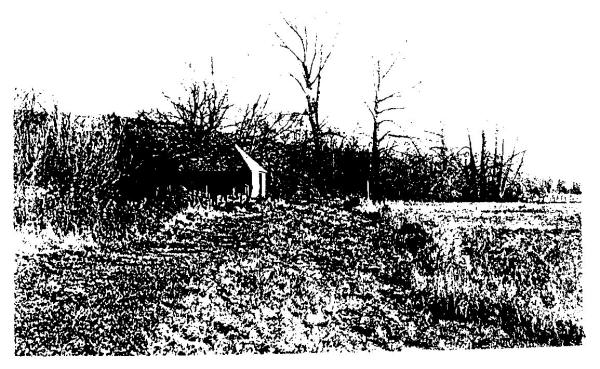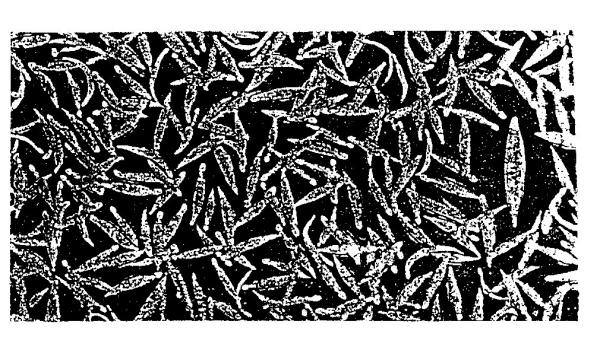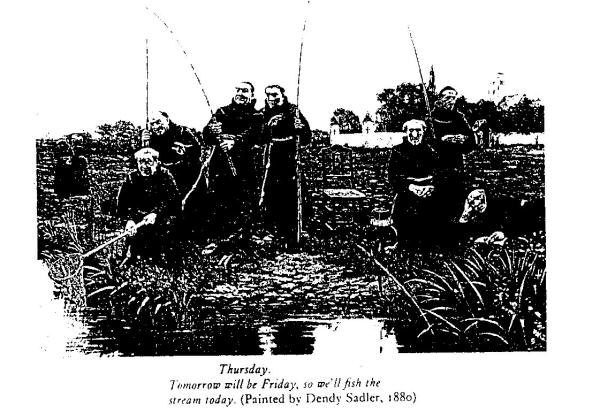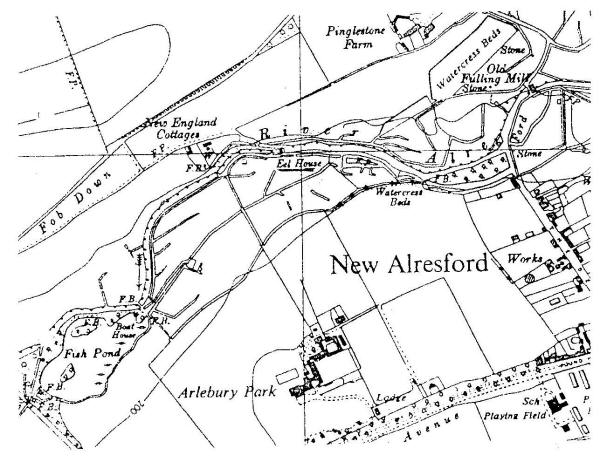No 79 THE EEL HOUSE AT ALRESFORD
by Raymond Elliott.
Gesner quotes Venerable Bede to say that 'In England there is an island called Ely by reason of the innumerable number of eels that breed in it.
Izaak Walton

The eel - Anquilla anguilla is said to be the first fish to achieve the dignity of a name and has been fished throughout most European countries for many centuries. To the ancient. Greeks the eel was the 'King of Fish' the white skinned Nymph: a Godess and was even considered to be a prophylatic. The Egyptians also considered the eel to be a god, and to the Athenians a dish of eels was the greatest of all delicacies.
The origin and life style of eels was a mystery for several centuries until the breeding grounds were firmly established by Dr. Schmidt, of the Denmark Scientific Council, in his searches from 1904 until completion in 1920.
The eel breeds in the deep Atlantic Ocean. known as the Sargasso Sea: between the Azores and the Bahamas. The adults return and breed here and then die, but the progeny, as minute specks of jelly at first, rise to near the surface and are carried by the warm currents of the Gulf Stream across the Atlantic Ocean to the shores of the countries of Europe, also into the enclosed Mediterranean Sea. On arrival at the coasts the tiny eels now three years old and known as elvers swim up most river estuaries - sometimes wriggling over land - to colonise most lakes, ponds and canals etc. There they stay and grow for ten to twenty years feeding on live and dead fish insects and spawn etc. In due course the urge to reproduce will turn the adult eel back to the far Sargasso Sea. Wriggling out of the inland home waters and if necessary, crossing country in wet weather, in early morning the eel continues travelling until reaching the river waters, swimming down to the estuary, and after waiting for a period of acclimatisation out to the sea. The journey along the Gulf Stream current back to the Sargasso Sea takes a further three years.
From Hampshire archives we can record that eel or fish houses have operated in the local rivers and meadows since at least the thirteenth century, being in earliest days controlled by the Bishop of Winchester and producing some forty thousand eels annually. Fish traps installed in the streams to the bishops pond and the rights to fishing at the corn and fulling mills were strictly controlled. In the seventeenth and eighteenth centuries records of fishing rights in the streams and mills also including a fish house the property of Sir Henry Tichborne at Ovington (where the Itchen, Arle and Candover streams meet at Borough Farm House. And today local fishermen remember the eel or fish houses that recently existed at Kingsworthy, Itchen Abbas and the Bush at Ovington. Also up to the Second World war sufficient quantities of eels were trapped each day from the waters passing under the Fulling Mill being transported direct to the railway station and on to the markets at London.
The eel house now standing unused in the water meadows was last in operation in the early nineteen fifties, i.e. some forty years ago. Sadly the quantity had by then considerably reduced making future fishing financially unviable and so the project was abandoned.

This existing Eel House, that strides the waters of the Arle in the Alresford meadows was built in circa 1825. It was first recorded by John Duthy in his much quoted book 'Sketches of Hampshire' describing his many rambles up and down the valley of the river Itchen He writes 'Walking down Drove Lane then turning right at the bottom....the road opens on to a turfy knoll called Fobdown where turning short to the right a footpath winds round the lower edge of the declivity to the very brink of the stream. Just at this point is a snug little cottage, with its diminutive garden, niched, like a water birds nest, admist the surrounding withy bushes and rushes. Passing thence over a single plank by some hatches and a fishing house, the path skirts the margin of the stream..... leading to that part of Alresford called The Dean. This section of the footpath described is incidentally part of the ancient pathway between Alresford and the hamlet of Abbotstone.
The water meadows that stretch around the north and west parts of New Alresford between the rivers and continuing line of hedging further up the slope, were in continuous occupation from the twelfth century until the year 1805 as pasturage for cows and horses owned by Alresford inhabitants. The bishop rented these lands at a standard charge for each horse or cow grazing thereon. The Enclosure Award of 1805 however that rearranged the ownership of all the lands caused the water meadows to be allocated to William Harris Lord Lieutenant of Hampshire who had earlier built Arlebury House.
Now the Itchen including the Arle is a regulated river controlled by the National Rivers Authority and many changes have been recorded in the last forty years. Hampshire Chronicle articles in 1966 stated that the Itchen waters were flowing as clear and full of fish as in the previous hundred years. Today however we read that according to recent tests on the water quality 'bacterial pollution levels in the river Itchen are still very high'. In the Hampshire Chronicle of January 1991 we are advised that a series of articles are to be published in the following months by Mr. Ron Holloway, a river keeper for twenty years. In his introduction Mr. Holloway states the problem in the series concerns the pollution of the waters from sewage effluent, fish farm effluent, cress farm effluent, road washings, agricultural run off and seepages and many other non point source pollutants. In low water periods the increasing amounts of pollutants are being diluted by 30 per cent less water with exceptionally high temperatures of the past summers. The dilution effect is just not working in these low water times'.

Distribution of the European eel [Anguilla anguilla] The figure shows the end product of Johannes Schmidt's years of research which proved that eels spawned in the sea and were originally marine fishes. The only spawning ground for thc European and the American eels is in the Sargasso area of the tropical Atlantic Ocean. The Gulf Stream carries leptoecphalus larvae across to Europe and up the American coast. The figures on the map show their length in millimetres at each stage of their journey. The edge of the dotted zone marks the point at which leptotephalae metamorphose into elvers.
... the austere, scrupulous regulations of the Romish Church have tended more than any other circumstances to enhance the value, and increase the quantity off this species of food so rigid was the precept upon this point that in the year 1629 Claude Guillon was beheaded at St Claude in Burgundy, for eating a morsel of Horseflesh on a Fish-day.
The Rev. W.B. Daniel, Rural Sports (1801)

Bearing in mind the recorded pollution in the River Itchen we note it is recorded that in nearby proximity to Hampshire the funneling effect of the British Channel and its consequent huge tidal range, each year brings millions of the tiny elvers into the Somerset levels on each tide. This year, 1992 owing to such large quantities the National Rivers Authority have again drafted into the area additional water bailiffs to catch the many poachers who are using their oversize nets to fish out the elvers from the centre of the rivers Parrott and Tone. These rivers are among the few areas left in the country where elvers can be caught in commercial quantities. The poached elvers are immediately shipped to the continent where they are sold - at inflated costs - to fish farms or to restock other rivers. Does this suggest that natural stocks of elvers and eels are declining worldwide?
However, persons who consider the consumption of eels to be a great delicacy need not dismay for the production of cultured eels is today a fast growing industry. Established some twenty or more years ago, on the west coast of Japan the almost. casual, but natural growth and life style of eels in their natural habitats has been replaced. The intensive culture covers a period of about twelve months. Today vast acreages of several concrete water tanks control the cultural growth and together with commercial air transport world wide trade is now well controlled together with local delivery.
From examination the structure of the Eel House in the Alresford water meadows appears to be in a remarkably sound condition. Erected in the 1820s it would have been built by William Harris, the owner of the site at that time. It is clearly recorded on the Tithe Map of 1843, it does not appear on the earlier Enclosure Map of 1807.
The brickwork of good Hampshire red brick appears to have benefited from the wet atmosphere of the river site and only minor repair work is required. The timber and tiled roof again is also quite sound but does need repair and maintenance in places. As an architect, I would welcome a proposal that this charming ancient rural building could be fully restored and perhaps then be available for an interested public to examine and admire. lt adds much to our knowledge and appreciation of the fishing and rural activities practised by our Alresford forbears stretching back to the days of that great prelate, Bishop Godfrey de Lucy, some nine hundreds ago.
Copyright Raymond Elliott. 1992

REFERENCES
Anglers Encyclopedia 1975
At the Tall of the Weir P.R. Chambers 1932
Marvellous Study Life of the Eel James Hornell 1934
Fishing for Eels Peter Wheat 1969
Sketches of Hampshire John Duthy 1839
George Watson New Alresford
Enclosure Map 1807 and Tithe Map
Western Daily Press March 1992
Hampshire Chronicle Jan 1991 and July 1992
Eel Culture Atsushi Usui 1974